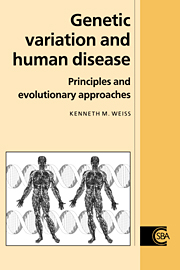Book contents
- Frontmatter
- Contents
- Frontispiece
- Preface: what is this book all about?
- Notational conventions used in this book
- List of abbreviations
- Part I Genes and their expression
- Part II Introduction to genetic epidemiology: inference from observational data
- Part III Evolution: the time dimension in populations
- Part IV Modification of the inherited genotype: the time dimension in individuals
- 12 Phenotype amplification by the environment
- 13 Infectious disease: the response to biological challenge
- 14 Variation within the inherited genotype
- 15 Cancer and aging: a microcosm of evolution during life
- Afterwords: towards a unified general model
- References
- Index
14 - Variation within the inherited genotype
from Part IV - Modification of the inherited genotype: the time dimension in individuals
Published online by Cambridge University Press: 05 June 2012
- Frontmatter
- Contents
- Frontispiece
- Preface: what is this book all about?
- Notational conventions used in this book
- List of abbreviations
- Part I Genes and their expression
- Part II Introduction to genetic epidemiology: inference from observational data
- Part III Evolution: the time dimension in populations
- Part IV Modification of the inherited genotype: the time dimension in individuals
- 12 Phenotype amplification by the environment
- 13 Infectious disease: the response to biological challenge
- 14 Variation within the inherited genotype
- 15 Cancer and aging: a microcosm of evolution during life
- Afterwords: towards a unified general model
- References
- Index
Summary
A beautiful theory slain by an ugly fact.
After T. H. Huxley ‘Biogenesis and abiogenesis’ (1892)An exception disproves the rule.
A. Conan Doyle, The Sign of the Four (1890)Some of our basic ideas about genes and their transmission have been established for nearly a century. One of these is Mendel's Law of Segregation, from which we derived the transmission probabilities (τs) given in Chapter 5. However, as noted earlier in this book, some investigators estimate these probabilities from the general likelihood in families rather than specifying them, and the estimates are sometimes significantly different from the mendelian values of 0, ½ and 1. A second basic principle of classical genetics is that genes are faithfully transmitted during mitosis, so that all of our somatic cells have the original inherited genotype. The process of somatic rearrangement in immunoglobulin and TcR genes shows that this postulate, also, is not always correct.
This chapter shows various other ways in which violations of these classical assumptions have important effects on the pattern of genotypes in families and the relationships between genotype and phenotype. The term non-traditional inheritance is often used for such phenomena {Hall, 1990a,b; Holliday, 1987, 1989; Solter, 1988}, but the mechanisms have always been there whether part of our ‘traditions’ or not!
- Type
- Chapter
- Information
- Genetic Variation and Human DiseasePrinciples and Evolutionary Approaches, pp. 273 - 285Publisher: Cambridge University PressPrint publication year: 1993



